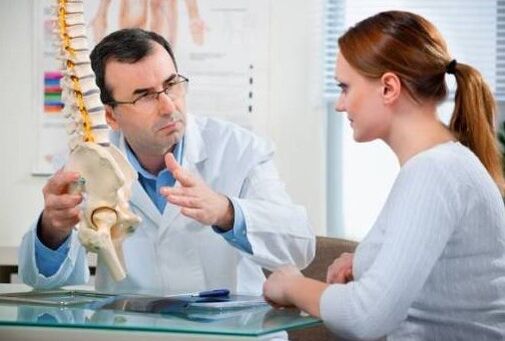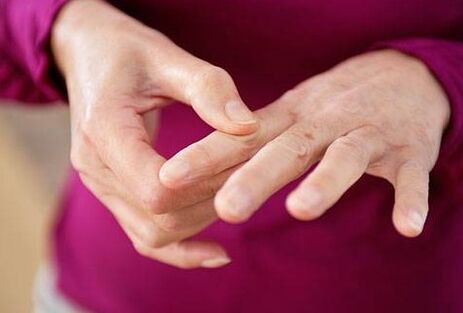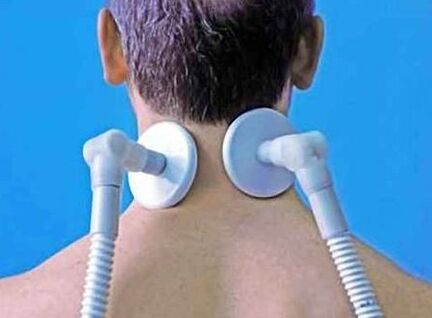
Stages of the development of pathology and their inherent symptomsThe entire process of developing osteochondrosis of the cervical column is divided into 4 main steps, each of which is accompanied by certain symptoms. The treatment depends completely on the established severity of the disease. For example, the first prepinational stage does not require drug treatment. To improve the patient's condition, it is recommended to radically review the lifestyle - perform physical exercises and eat well. The characteristic characteristics of this step: the excessive tension of the muscles of the whole back, the rapid appearance of a feeling of fatigue, a light but tangible pain in the times of the turns and the inclinations of the head. The main drawback in this case can be distinguished the fact that few people attach their importance to such symptoms, so they do not immediately turn to the hospital.
The following symptoms are characteristic of second degree osteochondrosis:The pain when moving the head becomes more intense and gives periodically to the shoulders, to the hands, even to the lower back;Pain syndrome can occur in a calm state;There are headache without cause;The attention is dispersed, the level of work capacity is reduced.All the above symptoms cannot continue to go unnoticed, therefore, for the most part, at this stage of the disease, the patient requires medical aid. The strengthening of pain is due to a decrease in the distance between the intervertebral discs and the offense of the nerves. An even greater worsening of the situation occurs in the third stage. In this case, the pain in the neck is constantly disturbing, the muscles of the hands become very weak, from time to time, numbness occurs. As for general symptoms, dizzy and weakness become the patient's daily companions. The cervical column loses mobility. Unbearable pain in the neck, shoulders, arms, ears in the ears, complete altered coordination and the appearance of obvious signs of other diseases indicate the start of the fourth final stage of osteochondosis. At the same time, the intervertebral discs are destroyed and the pathological process moves further along the spine, affecting other departments. Such degree of disease is difficult to treat, while the discretion of the doctor, surgery may be necessary. Thus, with the appearance of symptoms such as: pain in the neck and crunch during the movements of the head, hands of the hands, dizzy, nausea, headache, hands, as well as fatigue and coordination problems should become an alarming signal indicating real health problems. Do not delay a visit to the doctor, it is best to contact a therapist or immediately to a neuropathologist.In the process of progression of cervical osteochondosis, an offense to the spine may occur. Different sensitive disorders and motors may appear, depending on the spine, which has suffered:Partial or complete loss of sensitivity of the occipital region, in any part of the neck, shoulders and arms;Pain in one of the zones of the neck, shoulders, forearms, hands, to the fingertips;numbness of the language, which is why speech is altered;decrease in the muscular tone of the head and neck;Respiratory function problems, pain in the heart and liver.
The protruding edges of the vertebrae can press arteries through which blood penetrates the brain. Thus, the blood circulation in the brain is disturbed and additional symptoms appear: a clear change in mood, insomnia, anxiety without surety, for fear, irritability. At the same time, with blood vessel spasms, not only headache, but also eye pain can occur. Patients often note the appearance of "flies" in the eyes, sometimes fainting is possible. The reasons for the development of cervical osteochondosisThe most common cause of the appearance of cervical osteochondosis is considered a sedentary lifestyle in conjunction with incorrect and unbalanced nutrition. Often not only lazy people suffer from their nature, but also those whose profession most of the time requires passing or in the same uncomfortable installation: office employees, vehicle drivers, etc. Such a way of life causes a constant load on the cervical vertebrae, which is why muscle spasms arise. The appearance of degenerative processes in discs is due to a violation of metabolic processes and blood circulation. The other reasons for the development of cervical osteochondosis include:Excess weight caused by unhealthy nutrition;rheumatism, scoliosis, posture problems, flat feet;trauma of the spine and neck;Regular stress, nervous overvoltage;hereditary reason;Inné innate development of the cervical vertebrae.Too zealous practice sports, which means too intense physical activity can also become the previous factor in cervical osteochondosis. Primary disease in such conditions is most often a disc. The latter characterizes dystrophic disorders in intervertebral discs, mainly lumbar and cervical discord. Osteochondrosis in this case is a consequence of a disc. In addition to the exclusion of heavy physical effort, this diagnosis, complex treatment, medication and physiotherapeutic is necessary. 
The consequences of a progressive pathologyAmong the complications that can occur with the development of osteochondrosis in the cervical region must be distinguished:The hernies and the projection in the spine are formed in the third, the fourth stages due to the rapid progression of the underlying disease;The growth of bone tissue or the formation of osteophytes - are often prottube precursors. Osteophytes have an irritating effect on the muscles located nearby, increasing their tone. Thus, the pressure on the intervertebral discs increases. In addition, educated osteophytes can cause the arteries to shrink;The flattening of the vertebral disc - a decrease in the intervertebral hole leads to a decrease in the height between the intervertebral discs, the risk of subluxation of the cervical vertebrae with a net turn of the head increases;Spondylolistz or the displacement of the vertebral disk do not occur as often as other higher complications, however, in the event of occurrence, even death can even lead to death. Any minimum change in the position of the intervertebral disc with the greatest probability leads to paralysis, a more significant - to death. Cervical osteochondosis always causes an increase in blood pressure. In addition, the transition from the underlying disease from one stage to another contributes to the progression of hypertension from first to third degree, during which pressure exceeds the 180 mm mark. Treatment directly hypertension helps reduce the severity of symptoms, but only temporarily. In the case of non -dried osteochondosis, it is impossible to get rid of the increase in blood pressure. In the case of disk damage between cervical vertebrae 4 and 5, as a complication, periarthritis occurs. It characterizes the pinch of the nerves located to the connection of the shoulder joint with the hand. At the same time, intense pain occurs in the shoulder, having a negative effect on the mobility of the whole member. In addition, manifestations of osteochondrosis cannot be based on signs of heart disease, for example, to angina, but thanks to diagnostic measures, it is possible to differentiate diseases with great precision. It is impossible to determine osteochondrosis of the cervical column by palpation and due to a visual medical examination. Based on the history collected, the doctor can only assume that precisely osteochondosis has become the cause of a certain symptom. To confirm or refute such a hypothesis, a diagnosis is necessary. The most optimal way today is MRI or magnetic resonance therapy. This method allows you to consider all bone structures, to identify the presence of intervertebral hernias, the size of osteophytes and other characteristic complications of cervical osteochondosis. Another slightly less informative way is computed tomography. However, it allows you to establish a diagnosis, the determination of the size of the hernia, because its presence can be difficult.
Treatment of cervical osteochondosisThe treatment of osteochondrosis in the cervical region is always complex and complex. Its duration and saturation depend on the stage of development of the disease, the individual characteristics of the patient and the presence of other concomitant diseases. Among the main groups of drugs, which are often prescribed in the second stages and others, it should be distinguished: Analgesic or analgesic. The funds listed temporarily reduce pain. With too pronounced pain, the local blocking of novocaine is used.Non-steroidal anti-inflammatory drugs and steroid anti-inflammatory drugs. Non -steroidal agents are safer, they have an analgesic effect and can become an alternative to ordinary pain relievers. In case they did not relieve pain, steroids are used.Antidepressants and sedatives - mother -mother, Valérian dye. Their objective is due to two factors: if the cause of osteochondrosis is one on a nervous or the pain is so serious that it has a negative effect on the psyche. The use of these drugs should be carried out under strict observation, because each of the drugs has a number of contraindications and is addictive.Musorelaxants who help relieve muscle spasms. In combination with anti-inflammatory drugs, they have an analgesic effect.Vasransdilators who contribute to improving blood circulation.Drugs for the increase in immunity and normalization of metabolic processes are ideal for vitamins B and C.The complex of these drugs is a symptomatic treatment. Respect for all of the doctor's recommendations and the prescribed course will help eliminate pain and get rid of all unpleasant manifestations of the disease. However, the therapeutic course does not stop there. When the main characteristics are eliminated, which has worsened the quality of life, you can take the restoration of the cervical region in order to minimize the risk of relapse of the disease in the near future. Unfortunately, a huge error of many people is that after the disappearance of the symptoms, they consider themselves entirely in good health and abandon the treatment. In this situation, osteochondrosis will certainly remember after a while. Physiotherapy and traditional medicineThe following physiotherapeutic procedures are successfully used to treat cervical osteochondrosis:
Medical physical education - is carried out exclusively under the supervision of a qualified specialist, because with serious lesions of the intervertebral discs, incorrect exercises can still hurt the tissues;Manual therapy - is a manual effect on certain areas of the patient's body;Therapeutic massage;reflexology and, as a variety, acupuncture;Electrophoresis, balneotherapy, laser therapy, UFO, etc.Each of the above procedures has a number of contraindications, which is particularly important for those who have an anamnesis of other diseases which are not linked to osteochondrosis of the cervical column. The decision on the relevance of using a particular method remains with the attending physician. He may not be sure to make such measures of your free will. As for traditional medicine, you can use the grass of a sabrefish, bran. Fig. It is also recommended to reduce salt consumption. A responsible approach to the treatment of cervical osteochondosis will certainly allow you to get rid of the disease. Let this process take a long time, but only complex therapy will minimize the risk of developing the disease.


The reasons for the development of cervical osteochondosisThe most common cause of the appearance of cervical osteochondosis is considered a sedentary lifestyle in conjunction with incorrect and unbalanced nutrition. Often not only lazy people suffer from their nature, but also those whose profession most of the time requires passing or in the same uncomfortable installation: office employees, vehicle drivers, etc. Such a way of life causes a constant load on the cervical vertebrae, which is why muscle spasms arise. The appearance of degenerative processes in discs is due to a violation of metabolic processes and blood circulation. The other reasons for the development of cervical osteochondosis include:Excess weight caused by unhealthy nutrition;rheumatism, scoliosis, posture problems, flat feet;trauma of the spine and neck;Regular stress, nervous overvoltage;hereditary reason;Inné innate development of the cervical vertebrae.Too zealous practice sports, which means too intense physical activity can also become the previous factor in cervical osteochondosis. Primary disease in such conditions is most often a disc. The latter characterizes dystrophic disorders in intervertebral discs, mainly lumbar and cervical discord. Osteochondrosis in this case is a consequence of a disc. In addition to the exclusion of heavy physical effort, this diagnosis, complex treatment, medication and physiotherapeutic is necessary. 
The consequences of a progressive pathologyAmong the complications that can occur with the development of osteochondrosis in the cervical region must be distinguished:The hernies and the projection in the spine are formed in the third, the fourth stages due to the rapid progression of the underlying disease;The growth of bone tissue or the formation of osteophytes - are often prottube precursors. Osteophytes have an irritating effect on the muscles located nearby, increasing their tone. Thus, the pressure on the intervertebral discs increases. In addition, educated osteophytes can cause the arteries to shrink;The flattening of the vertebral disc - a decrease in the intervertebral hole leads to a decrease in the height between the intervertebral discs, the risk of subluxation of the cervical vertebrae with a net turn of the head increases;Spondylolistz or the displacement of the vertebral disk do not occur as often as other higher complications, however, in the event of occurrence, even death can even lead to death. Any minimum change in the position of the intervertebral disc with the greatest probability leads to paralysis, a more significant - to death. Cervical osteochondosis always causes an increase in blood pressure. In addition, the transition from the underlying disease from one stage to another contributes to the progression of hypertension from first to third degree, during which pressure exceeds the 180 mm mark. Treatment directly hypertension helps reduce the severity of symptoms, but only temporarily. In the case of non -dried osteochondosis, it is impossible to get rid of the increase in blood pressure. In the case of disk damage between cervical vertebrae 4 and 5, as a complication, periarthritis occurs. It characterizes the pinch of the nerves located to the connection of the shoulder joint with the hand. At the same time, intense pain occurs in the shoulder, having a negative effect on the mobility of the whole member. In addition, manifestations of osteochondrosis cannot be based on signs of heart disease, for example, to angina, but thanks to diagnostic measures, it is possible to differentiate diseases with great precision. It is impossible to determine osteochondrosis of the cervical column by palpation and due to a visual medical examination. Based on the history collected, the doctor can only assume that precisely osteochondosis has become the cause of a certain symptom. To confirm or refute such a hypothesis, a diagnosis is necessary. The most optimal way today is MRI or magnetic resonance therapy. This method allows you to consider all bone structures, to identify the presence of intervertebral hernias, the size of osteophytes and other characteristic complications of cervical osteochondosis. Another slightly less informative way is computed tomography. However, it allows you to establish a diagnosis, the determination of the size of the hernia, because its presence can be difficult.
Treatment of cervical osteochondosisThe treatment of osteochondrosis in the cervical region is always complex and complex. Its duration and saturation depend on the stage of development of the disease, the individual characteristics of the patient and the presence of other concomitant diseases. Among the main groups of drugs, which are often prescribed in the second stages and others, it should be distinguished: Analgesic or analgesic. The funds listed temporarily reduce pain. With too pronounced pain, the local blocking of novocaine is used.Non-steroidal anti-inflammatory drugs and steroid anti-inflammatory drugs. Non -steroidal agents are safer, they have an analgesic effect and can become an alternative to ordinary pain relievers. In case they did not relieve pain, steroids are used.Antidepressants and sedatives - mother -mother, Valérian dye. Their objective is due to two factors: if the cause of osteochondrosis is one on a nervous or the pain is so serious that it has a negative effect on the psyche. The use of these drugs should be carried out under strict observation, because each of the drugs has a number of contraindications and is addictive.Musorelaxants who help relieve muscle spasms. In combination with anti-inflammatory drugs, they have an analgesic effect.Vasransdilators who contribute to improving blood circulation.Drugs for the increase in immunity and normalization of metabolic processes are ideal for vitamins B and C.The complex of these drugs is a symptomatic treatment. Respect for all of the doctor's recommendations and the prescribed course will help eliminate pain and get rid of all unpleasant manifestations of the disease. However, the therapeutic course does not stop there. When the main characteristics are eliminated, which has worsened the quality of life, you can take the restoration of the cervical region in order to minimize the risk of relapse of the disease in the near future. Unfortunately, a huge error of many people is that after the disappearance of the symptoms, they consider themselves entirely in good health and abandon the treatment. In this situation, osteochondrosis will certainly remember after a while. Physiotherapy and traditional medicineThe following physiotherapeutic procedures are successfully used to treat cervical osteochondrosis:
Medical physical education - is carried out exclusively under the supervision of a qualified specialist, because with serious lesions of the intervertebral discs, incorrect exercises can still hurt the tissues;Manual therapy - is a manual effect on certain areas of the patient's body;Therapeutic massage;reflexology and, as a variety, acupuncture;Electrophoresis, balneotherapy, laser therapy, UFO, etc.Each of the above procedures has a number of contraindications, which is particularly important for those who have an anamnesis of other diseases which are not linked to osteochondrosis of the cervical column. The decision on the relevance of using a particular method remains with the attending physician. He may not be sure to make such measures of your free will. As for traditional medicine, you can use the grass of a sabrefish, bran. Fig. It is also recommended to reduce salt consumption. A responsible approach to the treatment of cervical osteochondosis will certainly allow you to get rid of the disease. Let this process take a long time, but only complex therapy will minimize the risk of developing the disease.

The consequences of a progressive pathologyAmong the complications that can occur with the development of osteochondrosis in the cervical region must be distinguished:The hernies and the projection in the spine are formed in the third, the fourth stages due to the rapid progression of the underlying disease;The growth of bone tissue or the formation of osteophytes - are often prottube precursors. Osteophytes have an irritating effect on the muscles located nearby, increasing their tone. Thus, the pressure on the intervertebral discs increases. In addition, educated osteophytes can cause the arteries to shrink;The flattening of the vertebral disc - a decrease in the intervertebral hole leads to a decrease in the height between the intervertebral discs, the risk of subluxation of the cervical vertebrae with a net turn of the head increases;Spondylolistz or the displacement of the vertebral disk do not occur as often as other higher complications, however, in the event of occurrence, even death can even lead to death. Any minimum change in the position of the intervertebral disc with the greatest probability leads to paralysis, a more significant - to death. Cervical osteochondosis always causes an increase in blood pressure. In addition, the transition from the underlying disease from one stage to another contributes to the progression of hypertension from first to third degree, during which pressure exceeds the 180 mm mark. Treatment directly hypertension helps reduce the severity of symptoms, but only temporarily. In the case of non -dried osteochondosis, it is impossible to get rid of the increase in blood pressure. In the case of disk damage between cervical vertebrae 4 and 5, as a complication, periarthritis occurs. It characterizes the pinch of the nerves located to the connection of the shoulder joint with the hand. At the same time, intense pain occurs in the shoulder, having a negative effect on the mobility of the whole member. In addition, manifestations of osteochondrosis cannot be based on signs of heart disease, for example, to angina, but thanks to diagnostic measures, it is possible to differentiate diseases with great precision. It is impossible to determine osteochondrosis of the cervical column by palpation and due to a visual medical examination. Based on the history collected, the doctor can only assume that precisely osteochondosis has become the cause of a certain symptom. To confirm or refute such a hypothesis, a diagnosis is necessary. The most optimal way today is MRI or magnetic resonance therapy. This method allows you to consider all bone structures, to identify the presence of intervertebral hernias, the size of osteophytes and other characteristic complications of cervical osteochondosis. Another slightly less informative way is computed tomography. However, it allows you to establish a diagnosis, the determination of the size of the hernia, because its presence can be difficult.
Treatment of cervical osteochondosisThe treatment of osteochondrosis in the cervical region is always complex and complex. Its duration and saturation depend on the stage of development of the disease, the individual characteristics of the patient and the presence of other concomitant diseases. Among the main groups of drugs, which are often prescribed in the second stages and others, it should be distinguished: Analgesic or analgesic. The funds listed temporarily reduce pain. With too pronounced pain, the local blocking of novocaine is used.Non-steroidal anti-inflammatory drugs and steroid anti-inflammatory drugs. Non -steroidal agents are safer, they have an analgesic effect and can become an alternative to ordinary pain relievers. In case they did not relieve pain, steroids are used.Antidepressants and sedatives - mother -mother, Valérian dye. Their objective is due to two factors: if the cause of osteochondrosis is one on a nervous or the pain is so serious that it has a negative effect on the psyche. The use of these drugs should be carried out under strict observation, because each of the drugs has a number of contraindications and is addictive.Musorelaxants who help relieve muscle spasms. In combination with anti-inflammatory drugs, they have an analgesic effect.Vasransdilators who contribute to improving blood circulation.Drugs for the increase in immunity and normalization of metabolic processes are ideal for vitamins B and C.The complex of these drugs is a symptomatic treatment. Respect for all of the doctor's recommendations and the prescribed course will help eliminate pain and get rid of all unpleasant manifestations of the disease. However, the therapeutic course does not stop there. When the main characteristics are eliminated, which has worsened the quality of life, you can take the restoration of the cervical region in order to minimize the risk of relapse of the disease in the near future. Unfortunately, a huge error of many people is that after the disappearance of the symptoms, they consider themselves entirely in good health and abandon the treatment. In this situation, osteochondrosis will certainly remember after a while. Physiotherapy and traditional medicineThe following physiotherapeutic procedures are successfully used to treat cervical osteochondrosis:
Medical physical education - is carried out exclusively under the supervision of a qualified specialist, because with serious lesions of the intervertebral discs, incorrect exercises can still hurt the tissues;Manual therapy - is a manual effect on certain areas of the patient's body;Therapeutic massage;reflexology and, as a variety, acupuncture;Electrophoresis, balneotherapy, laser therapy, UFO, etc.Each of the above procedures has a number of contraindications, which is particularly important for those who have an anamnesis of other diseases which are not linked to osteochondrosis of the cervical column. The decision on the relevance of using a particular method remains with the attending physician. He may not be sure to make such measures of your free will. As for traditional medicine, you can use the grass of a sabrefish, bran. Fig. It is also recommended to reduce salt consumption. A responsible approach to the treatment of cervical osteochondosis will certainly allow you to get rid of the disease. Let this process take a long time, but only complex therapy will minimize the risk of developing the disease.

Treatment of cervical osteochondosisThe treatment of osteochondrosis in the cervical region is always complex and complex. Its duration and saturation depend on the stage of development of the disease, the individual characteristics of the patient and the presence of other concomitant diseases. Among the main groups of drugs, which are often prescribed in the second stages and others, it should be distinguished: Analgesic or analgesic. The funds listed temporarily reduce pain. With too pronounced pain, the local blocking of novocaine is used.Non-steroidal anti-inflammatory drugs and steroid anti-inflammatory drugs. Non -steroidal agents are safer, they have an analgesic effect and can become an alternative to ordinary pain relievers. In case they did not relieve pain, steroids are used.Antidepressants and sedatives - mother -mother, Valérian dye. Their objective is due to two factors: if the cause of osteochondrosis is one on a nervous or the pain is so serious that it has a negative effect on the psyche. The use of these drugs should be carried out under strict observation, because each of the drugs has a number of contraindications and is addictive.Musorelaxants who help relieve muscle spasms. In combination with anti-inflammatory drugs, they have an analgesic effect.Vasransdilators who contribute to improving blood circulation.Drugs for the increase in immunity and normalization of metabolic processes are ideal for vitamins B and C.The complex of these drugs is a symptomatic treatment. Respect for all of the doctor's recommendations and the prescribed course will help eliminate pain and get rid of all unpleasant manifestations of the disease. However, the therapeutic course does not stop there. When the main characteristics are eliminated, which has worsened the quality of life, you can take the restoration of the cervical region in order to minimize the risk of relapse of the disease in the near future. Unfortunately, a huge error of many people is that after the disappearance of the symptoms, they consider themselves entirely in good health and abandon the treatment. In this situation, osteochondrosis will certainly remember after a while. Physiotherapy and traditional medicineThe following physiotherapeutic procedures are successfully used to treat cervical osteochondrosis:
Medical physical education - is carried out exclusively under the supervision of a qualified specialist, because with serious lesions of the intervertebral discs, incorrect exercises can still hurt the tissues;Manual therapy - is a manual effect on certain areas of the patient's body;Therapeutic massage;reflexology and, as a variety, acupuncture;Electrophoresis, balneotherapy, laser therapy, UFO, etc.Each of the above procedures has a number of contraindications, which is particularly important for those who have an anamnesis of other diseases which are not linked to osteochondrosis of the cervical column. The decision on the relevance of using a particular method remains with the attending physician. He may not be sure to make such measures of your free will. As for traditional medicine, you can use the grass of a sabrefish, bran. Fig. It is also recommended to reduce salt consumption. A responsible approach to the treatment of cervical osteochondosis will certainly allow you to get rid of the disease. Let this process take a long time, but only complex therapy will minimize the risk of developing the disease.
Physiotherapy and traditional medicineThe following physiotherapeutic procedures are successfully used to treat cervical osteochondrosis:
Medical physical education - is carried out exclusively under the supervision of a qualified specialist, because with serious lesions of the intervertebral discs, incorrect exercises can still hurt the tissues;Manual therapy - is a manual effect on certain areas of the patient's body;Therapeutic massage;reflexology and, as a variety, acupuncture;Electrophoresis, balneotherapy, laser therapy, UFO, etc.Each of the above procedures has a number of contraindications, which is particularly important for those who have an anamnesis of other diseases which are not linked to osteochondrosis of the cervical column. The decision on the relevance of using a particular method remains with the attending physician. He may not be sure to make such measures of your free will. As for traditional medicine, you can use the grass of a sabrefish, bran. Fig. It is also recommended to reduce salt consumption. A responsible approach to the treatment of cervical osteochondosis will certainly allow you to get rid of the disease. Let this process take a long time, but only complex therapy will minimize the risk of developing the disease.


























